Spray Polyurethane Foam Application: When Are Workers Safe?
Emissions data collected following spray polyurethane foam application has been used to estimate the time required for workers to safely re-enter and work without respiratory protection.





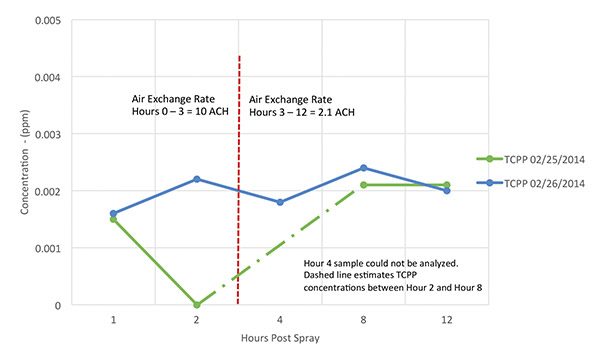
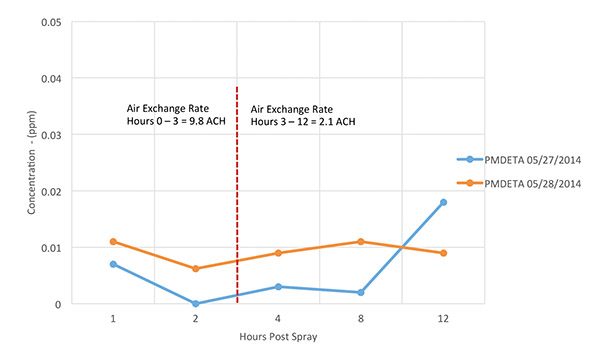

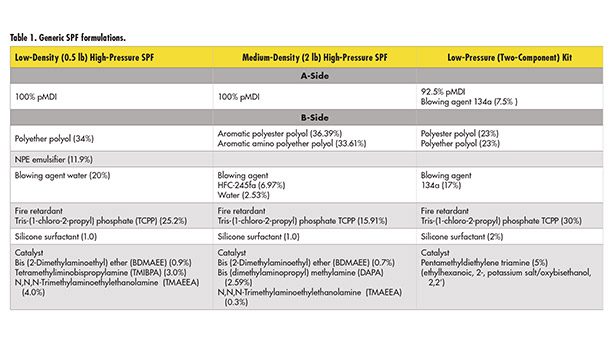
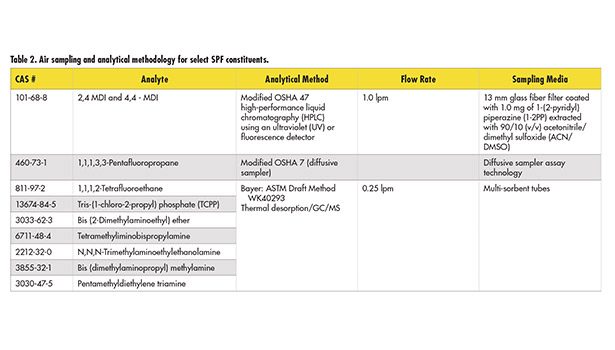


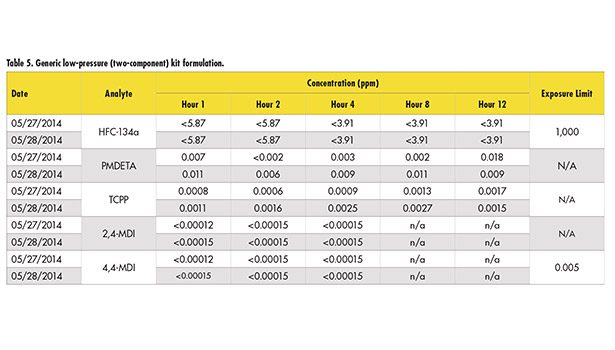













The determination of trade worker re-entry time following the application of spray polyurethane foam (SPF) in residential and commercial buildings has traditionally been estimated by SPF manufacturers. Frequently, decisions related to the time required for airborne concentrations of SPF chemical components to fall to within acceptable levels have been based on qualitative information such as comfort and odor. Other factors considered have included building volume, mechanical and natural ventilation.
The research detailed in this paper focused on the evaluation and impact of SPF emissions on healthy adults working an average of 8-10 hours per day. Emissions data collected following SPF application was used to determine chemical degradation times to estimate the time required for workers to safely re-enter and work without respiratory protection.
This Center for the Polyurethanes Industry (CPI) re-entry research builds on the Phase 1 and 2 work completed during the CPI Ventilation Research Project. During Phase 1 of that study, three generic SPF formulations were developed to represent those currently available in the SPF marketplace. The generic formulations included a low-density high-pressure formulation; a medium-density high-pressure formulation; and a low-pressure kit formulation.
During Phase 2 of the study, generic formulations were to be sprayed at three ventilation rates—10 air changes per hour (ACH), 233 ACH and 598 ACH—while the spray applicator was monitored for airborne SPF chemical components. Fixed area samples were also collected during application and 30 min following application.
Although the medium-density formulation was evaluated at 10.4 ACH, 233 ACH and 598 ACH, all three generic formulations were evaluated only at the 10.4 ACH rate. Since worker exposure data was available for the SPF application of the three generic formulations at 10.4 ACH, the CPI Ventilation Task Force selected the 10.4 ACHventilation rate as the starting point for the re-entry research. Once completed, the ventilation research and re-entry research could be compared to provide a complete view of the time required from application to re-entry for each generic formulation at the 10.4 ACH ventilation rate.
Research Protocol for SPF Re-Entry Study
Knowledge and experience related to the selection and use of mechanical ventilation to control emissions during and following SPF application varies widely among contractors. Consequently, contractors often rely on government-required personal protective equipment (PPE) for spray applicators and helpers, while mechanical ventilation may be used to supplement PPE and reduce emissions in surrounding areas of the building.
Due to variations in the use of effective mechanical ventilation, this study has been designed to represent a feasible worst-case scenario for residential or commercial SPF application. It is thought that the majority of contractors will use barriers and portable exhaust ventilation as recommended by the U.S. Environmental Protection Agency (EPA) and the SPF industry; however, it is plausible that some will remove the portable ventilation at the end of the day/project so it can be used at another location the following day. This would be especially true for small retrofit projects. The protocol selected for this study was designed to reflect this scenario.
Exhaust ventilation is supplied to the work area during application and is removed several hours later when the contractor leaves the site and other trade workers arrive to provide other services. To simulate this scenario, the generic formulations were sprayed for a 15-min period at 10 ACH. The ventilation continued to operate at 10 ACH for three hours following application, but was then reduced to 1-2 ACH for the remaining test period to represent minimal passive ventilation that would be expected from an open door or windows.
Emissions from the generic high-pressure low-density, medium-density SPF and low-pressure two-component kit formulations were evaluated in a ventilated room operating at an air exchange rate of 10 and 1-2 ACH. Chemicals selected for evaluation represent those typically present in SPF formulation, including:
• Methylene diphenyl diisocyanate (MDI)
• Amine catalysts
• Blowing agents other than water
• Flame retardants
Facilities, Equipment and Application
Area air monitoring was conducted while generic formulations were applied to test panels inside a ventilated spray room. The ventilated spray room was designed to meet the following specifications:
• The dimensions of the spray room are approximately 8 x 8 x 8 ft. Make-up air is supplied to the room and it is exhausted though an 8 x 8-ft filter bank on the opposite wall of the room.
• The spray substrate consisted of 2 x 4-in. studs, 7 ft high and spaced 16 in. apart, providing two cavities lined with cardboard inserts for SPF application. The total size of the spray structure was approximately 3 x 7 ft, representing a typical wall cavity.
The SPF applicator sprayed the generic high-pressure formulations using a Graco Fusion Air Purge 01 round tip spray gun. The generic low-pressure kit formulation was sprayed using manufacturer-supplied spray equipment. SPF was applied under the following conditions:
• Ambient air temperature of 75-80°F with 50% relative humidity
• Samples were sprayed using manufacturer-recommended pressure.
• The system was heated to the manufacturer-recommended temperature.
• Samples were sprayed while maintaining a 12-24 in. distance from the substrate being sprayed.
• Inserts were removed and stacked in the room when SPF application was completed; the cardboard inserts were then replaced and SPF application continued.
• A 3 x 7-ft area was sprayed in one pass at a nominal thickness of 2 in. for medium-density (2 lb) SPF, 4 in. for low-density (½ lb) SPF, and 2 in. for low-pressure kit SPF.
• The amount of foam used (lbs) and the densities of the foams sprayed were recorded.
Test Protocol
Air sampling for the chemical ingredients selected for evaluation were conducted by a third-party contractor according to applicable sampling and analytical protocols:
• Two sessions of area sampling were conducted for each SPF formulation (low-density high-pressure SPF, medium-density high-pressure SPF, and low-pressure kit SPF) following application to the spray substrate.
• SPF formulations were applied for 15 min for each air sampling test.
• SPF formulations were applied at the target ventilation rate of 10 ACH. Actual ventilation rates varied for each two-day air sampling session.
• Following application, sprayed inserts remained in the ventilated spray room with ventilation operating at 10 ACH.
• The air samplers were located near the center of the room, approximately 6 ft off the floor. Following the monitoring session, samples were submitted to a several qualified laboratories for analysis.
• Air sampling was conducted according to the following schedule:
-Hour 1—Air sampling was initiated one hour after application.
-Hour 2—At the completion of Hour 1 sampling, air samplers were replaced with a second set of air samplers.
-Hour 3—At the completion of Hour 2 sampling, ventilation was reduced from 10 ACH to a target rate of 1 ACH. The ventilation rate continued to operate at 1 ACH for one hour. Air sampling was not conducted during Hour 3 so that the ventilation could stabilize.
-Hour 4—A a third set of air samplers was placed in the ventilated room. The ventilation rate continued at 1 ACH.
-Hour 8—A fourth set of air samplers was placed in the ventilated room.
-Hour 12—A fifth set of air samplers was placed in the ventilated room. Ventilation continued at 1 ACH.
Generic High-Pressure Medium-Density Formulation
Samples were collected at a measured ventilation rate of 9.2 ACH at one and two hours after SPF application. Beginning three hours after application, the ventilation rate was reduced to a measured air exchange rate of 1.7 ACH. Air samples were again collected at four, eight and 12 hours after application at 1.7 ACH. The “A-Side” MDI vapor was monitored during Hours 1, 2 and 4 only, since no detectable concentrations of MDI were expected throughout the 12-hour study period. The “B-Side” components were monitored at each target hour.
All samples were collected for 20 min, with the exception of MDI. MDI samples were collected for 60 min to meet acceptable analytical detection limits. Sample times bracketed each target hour (e.g., 20 min samples began 10 min before the hour and ended 10 min after the hour).
Air samples were collected prior to spraying the generic formulations to measure potential background concentrations of the SPF components. Field blanks were also submitted following each round of testing. Analysis of background and field blank samples indicated small amounts of SPF components in two samples; however, the quantities were considered insignificant.
The results of analysis are listed in Table 3 and displayed in Figures 2-4. There were no measureable airborne concentrations of either 2,4-MDI or 4,4-MDI in the samples collected one, two and four hours after application. MDI aerosol and vapor has been shown to be present during spray application of the generic medium-density formulation; however, it was not detected after one hour following application. The detection limits ranged from 0.00014 to 0.00016 ppm, which is significantly below the occupational exposure limit of 0.005 ppm for 4,4-MDI.
Amine catalyst concentrations listed in Table 3 ranged from below detection limits to 0.023 ppm. Figure 2 displays the data in graphical form and includes the occupational exposure limit (OEL) for BDMAEE, as a point of reference. BDMAEE is the only amine catalyst in the generic formulation that has been assigned an OEL. The American Conference of Governmental Industrial Hygienists (ACGIH) has assigned BDMAEE a threshold limit value of 0.05 ppm, as an eight-hour time-weighted average concentration (TLV-TWA).
The highest concentration measured during the two-day study was approximatelyhalf the recommended value. This occurred within one hour following application. The concentration continued to decrease during the second hour and increased slightly during the fourth hour after the ventilation had been lowered to 1.7 ACH. TMAEEA, a non-emissive catalyst, was not detected in any of the samples; however, it must be noted that the reported TMAEEA values are semi-quantitative since the compound degrades due to the thermal desorption during sample analysis. DAPA, an emissive catalyst, followed emission patterns similar to BDMAEE. Concentrations decreased from the first to the second hour as the ventilation rate equaled 9.2 ACH. At the fourth hour following SPF application, concentrations of the catalysts, BDMAEE and DAPA, increased or remained the same at 1.7 ACH. Concentrations then generally remained steady or decreased slightly from Hours 4 through 12.
TCPP concentrations ranged from below 1 ppb to 3 ppb (see Table 3 and Figure 3). Concentrations were highest one hour after application, dropping in half by the second hour. At Hours 4 through 12, concentrations remained at approximately 1 ppb at the reduced air exchange rate of 1.7 ACH. There are no published OELs for TCPP; however, emissions from the closed cell generic formulation were negligible.
Concentrations of the blowing agent, HFC 245fa, followed the same pattern as the other B-Side components (see Table 3 and Figure 4). Concentrations dropped significantly from the first to the second hour, and rose again in the fourth hour after the air exchange rate was reduced. The OEL of 300 ppm was established as a Workplace Environmental Exposure Level (WEEL) by the American Industrial Hygiene Association (AIHA). The WEEL is an eight-hour TWA concentration. The WEEL has been added to Figure 4 as a point of reference, indicating acceptable emissions of blowing agent in terms of worker exposure. Although detectable, HFC 245fa concentrations were more than three times lower for the 12-hour period following application, even at the reduced ventilation rate of 1.7 ACH.
Conclusions
Concentrations of MDI, BDMAEE and HFC245fa were well within occupational exposure limits beginning 1-12 hours after application. Although the measurements do not represent actual worker exposure assessments, the chemicals emitted would not present a significant airborne risk to healthy adult trade workers entering the area following application. All measured chemicals decreased from the first hour following application, rose again as the air exchange rate was decreased from 9.2 to 1.7 ACH four hours application, and then either remained steady or decreased until the completion of the monitoring 12 hours after application.
Using established OELs as safe eight-hour exposure concentrations for healthy adult trade workers as a benchmark, and considering 9.2 ACH may have partially controlled emissions during Hour 1 through Hour 3, trade workers could safely re-enter the work area sprayed with the generic formulation after four hours without the use of respiratory protection. This re-entry time is also based on the assumption that the passive ventilation rate of 1.7 ACH would provide limited control of SPF emissions.
Generic Low-Density High-Pressure Formulation
The study protocol previously described was followed for the generic high-pressure low-density formulation. Chemicals monitored included: MDI, three amine catalysts, and the fire retardant TCPP. Blowing agent samples were not collected, since water is used in the low-density formulation. Similar to the medium-density formulation, samples were collected at a measured ventilation rate of 10 ACH at one and two hours after SPF application. Beginning three hours after application, the ventilation rate was reduced to a measured ventilation rate of 2.1 ACH. Air samples were again collected at four, eight and 12 hours after application at 2.1 ACH. A-Side MDI vapor was monitored during hours 1, 2, and 4. B-Side components were monitored at each target hour. All samples were collected for 20 min, with the exception of MDI (collected for 60 min). Sample times bracketed each target hour.
Air samples were collected prior to spraying the generic formulation to measure potential background concentrations of the SPF components. Field blanks were also submitted following each round of testing. Analysis of background and field blank samples indicated a trace quantity of BDMAEE in one sample; however, the concentration was not significant.
The results of analysis are listed in Table 4 and displayed in Figures 5 and 6. There were no measureable airborne concentrations of either 2.4-MDI or 4,4-MDI in samples collected one, two and four hours after application. The MDI detection limits ranged from 0.00014 to 0.00016 ppm, which is significantly below the OEL of 0.005 ppm for 4,4-MDI.
One thermal desorption tube sample collected at Hour 4 on the first day of the study could not be analyzed. Therefore, BDMAEE and TCPP Hour 4 concentrations have been estimated and displayed as a dashed line connecting the Hour 2 results to the Hour 8 results on Figures 5 and 6. The sample is listed as “Void” in Table 4.
BDMAEE was detected in all thermal desorption tube samples, while TMIBPA and TMAEEA were not detected in any air sample. As demonstrated in Table 4 and Figure 5, BDMAEE concentrations were generally above the ACGIH TLV-TWA of 0.05 ppm. Only one sample collected during the second hour after application resulted in a BDMAEE concentration less than the TLV-TWA. BDMAEE concentrations decreased from Hour 1 to Hour 2 following application, but rose again at Hour 4 after the ventilation rate was reduced to 2.1 ACH. Concentrations continued to rise at Hour 8 and 12 following application on the first day of sampling, decreasing slightly at Hour 12 on the second day.
The quantity of BDMAEE in the high-pressure medium-density formulation and the low-density formulation are similar (0.7% medium density/0.9% low density); therefore, the difference in BDMAEE emissions between the two formulations is likely due to the open cell nature of the low-density foam. BDMAEE is an emissive catalyst that is not bound in the cured formulation and will readily emit from an open cell foam over time, while the closed cell formulation will encapsulate the catalyst resulting in reduced emissions over time.
TCPP emissions varied between Day 1 and Day 2 of the study; however, concentrations were very low, close to the analytical detection limit. On the second day, TCPP concentrations rose slightly from the first to second hour, and remained at approximately 2 ppb for Hours 4-12. Hours 8-12 on the first day of testing resulted in the same 2 ppb TCPP concentration.
Conclusions
Concentrations of 2,2 and 2,4 MDI and the amine catalysts TMEEA and TMIBPA were below detection limits. TCPP was present at very low part-per-billion concentrations, slightly above analytical detection limits. BDMAEE concentrations, however, generally exceeded the ACGIH TLV-TWA during the 12-hour study period. Although the catalyst measurements do not represent actual worker exposure, trade workers entering the area where the generic high-pressure open cell formulation had been sprayed would require respiratory protection in addition to other required PPE.
Generic Low-Pressure Two-Component Kit Formulation
The study protocol used for the generic high-pressure medium-density and low-density formulations was again followed for the low-pressure kit formulation. Chemicals measured included: MDI, one amine catalyst, PMDTA, the fire retardant TCPP, and the blowing agent HFC 134a. Air samples were collected at a measured ventilation rate of 9.2 ACH at one and two hours after SPF application. Beginning three hours after application, the ventilation rate was reduced to a measured air exchange rate of 2.1 ACH, and air samples were again collected at four, eight and 12 hours after application.
A-Side MDI vapor was monitored during Hours 1, 2 and 4. B-Side components were monitored at each target hour. Catalyst and fire retardant samples were collected for 20 min, while MDI and HF 134a were collected for 60 min. Sample times again bracketed each target hour.
Air samples were collected prior to spraying the generic kit formulation to measure potential background concentrations of the SPF components. Field blanks were also submitted following each round of testing. No test components were detected in background samples or field blanks.
The results of analysis are listed in Table 5 and shown in Figures 7 and 8. There were no measureable airborne concentrations of either 2.4-MDI or 4,4-MDI in samples collected one, two and four hours after application. The MDI detection limits ranged from 0.00014 to 0.00016 ppm. The blowing agent HFC 134a was also not detected in any sample collected during the 12-hour study period. The detection limits for the blowing agent were 3.91 ppm to 5.91 ppm, which is far below the AIHA WEEL of 1,000 ppm.
Pentamethyldiethylene triamine (PMDETA) concentrations listed in Table 5 and Figure 7 indicate the amine catalyst was detected in all samples, with the exception of the sample collected at Hour 2, Day 1. Catalyst concentrations were low on each day of the study, ranging from non-detect to 0.018 ppm. PMDETA concentrations either decreased slightly or remained the same between Hours 1 and 2, and remained the same or increased slightly as the ventilation was decreased at Hour 4. On Day 1, Hour 12 the PMDETA concentration rose from 0.002 ppm to 0.018 ppm. Although there is no clear reason for the increase, the variation is likely due to the fact that emissions were near the analytical detection limit where a slight increase in amine concentration would appear significant. Concentrations would likely return to the observed low concentrations if air sampling continued beyond the 12-hour period.
The fire retardant TCPP varied by several parts per billion between the between the first and second day of air sampling. During the first day of the study, TCPP concentrations followed the previously observed pattern of a decrease from Hour 1 to Hour 2, and then a gradual increase after Hour 4. TCPP concentrations on the second day remained steady at approximately 45 ppb and dropped to 15 ppb a Hour 12. Like the amine catalyst, concentrations were very low, with the variation attributable to slight changes in environmental conditions or analytical sensitivity.
Conclusions
Concentrations of 2,2 and 2,4 MDI and the blowing agent HFC134a were below detection limits. TCPP and the amine catalyst PMDETA were present at very low part-per-billion concentrations, slightly above analytical detection limits. Based on the reported results of this study, long-term emissions from the generic kit formulation were low and would not pose a significant risk to the health of trade workers entering the sprayed area four hours after application.
Overall Results
2,4-MDI or 4,4-MDI
There were no measureable airborne concentrations of either 2,4-MDI or 4,4-MDI in the samples collected one, two and four hours after application. MDI has been shown to be present during spray application; however, MDI vapor could not be detected in any sample after one hour following application. The detection limits ranged from 0.00014 to 0.00016 ppm, which is significantly below the occupational exposure limit of 0.005 ppm for 4,4-MDI.
Amine Catalysts
Measurable quantities of amine catalyst were detected in each generic formulation; however, only one of the five catalysts present in the three formulations, bis (2-dimethylanoethyl) ether (BDMAEE), has been assigned an OEL. The American Conference of Governmental Industrial Hygienists has assigned BDMAEE a threshold limit value (TLV-TWA) of 0.05 ppm. In a status report regarding the five amine catalysts in the CPI generic formulations, the Consumer Product Safety Commission (CPSC) reported, “Four of the five amine catalysts had very limited toxicological or exposure data to review; therefore, data relevant to amine catalyst toxicity is based on the chemical with the most information, bis (2-dimethylanoethyl) ether.”
Using CPSC’s approach as a guide for interpretation, with the exception of BDMAEE, catalyst emissions from the high-pressure medium-density formulation and the low-pressure kit formulation would be considered acceptable beginning one hour after application, given the ventilation rates used for this study. BDMAEE emissions measured during the post application of the low-density high-pressure open cell formulation at the ventilation rates used for this study were in excess of the 0.05 ppm TLV-TWA and would not be considered acceptable for unprotected trade workers following application.
Tris-(1-chloro-2propyl) phosphate (TCPP)
The generic formulations contain significant quantities of TCPP ranging from 16 to 30% of the total B-Side formulation. Although the quantity is significant, most fire retardant remains in the SPF once the material is applied. Following application, as the foam temperature decreases, low ppb concentrations of TCPP were emitted. Although there are no established exposure limits for TCPP, the measured concentrations 1-12 hours after application were near analytical detection limits and likely would not pose a risk to the health of unprotected trade workers at the ventilation rates used for this study.
Blowing Agents HFC-145fa and HFC-134a
Measurable quantities of HFC-145fa were detected 1-12 hours after application of the high-pressure medium-density formulation. All concentrations were less than 1 ppm, which is well within the occupational exposure limit of 300 ppm set by the AIHA WEEL committee. Concentrations of HFC-134a used in the low-pressure kit formulation were below analytical detection limits. The WEEL committee has set an OEL of 1,000 ppm for HFC-134a. Based on the findings, blowing agent concentrations emitted from the generic high-pressure medium-density formulation and the low-pressure kit formulation would likely not pose a risk to the health of unprotected trade workers at the ventilation rates used for this study.
Re-Entry Study Conclusions
Several conclusions can be drawn from the data generated. In the absence of properly designed ventilation, SPF emissions can be expected to vary between formulations. It is also evident that if the CPI generic formulations represent typical SPF formulations in commercial use today, MDI vapor does not present a significant airborne health risk to unprotected trade workers beginning one hour after application, even when using minimal exhaust ventilation.
Certain emissive catalysts, such as BDMAEE, are not bound within the sprayed open cell formulation and will continue to be released at concentrations above the occupational exposure limit 12 hours after application if ventilation is not sufficient to control emissions. BDMAEE in the closed cell formulation did not exceed the occupational exposure limit at any time during the 12-hour period. Non-emissive catalysts, such as TMAEEA and TMIBPA present in the same open cell formulation, were bound to the spray foam and were below the detection limits throughout the test period. Given the environmental conditions and the protocol used in this study, other components such as TCPP and the blowing agents HFC-245fa and HFC-134a would not pose a significant health risk for unprotected workers at the ventilation rates used for this study.
Based on the results of this study, it is apparent that that emissions of SPF chemicals vary depending on the type of foam (open cell vs. closed cell) and the specific chemicals comprising the B-Side of the formulation. It is therefore essential that emissions from commercial SPF formulations, in particular open cell formulations, be controlled through the use of mechanical ventilation during application and for 12 hours or more following application. Control effectiveness should be evaluated though industrial hygiene air monitoring. The use of respiratory protection must then be used to supplement ventilation where worker exposure to SPF chemicals cannot be controlled.
In those instances where SPF producers desire reduced re-entry times for commercial products, those formulations should be evaluated in the laboratory using similar ventilation rates used in this study. Laboratory studies should then be validated in the field with contractor-provided mechanical ventilation.
For additional information, contact the author at woodrd665@gmail.com or visit www.airproducts.com.
Author’s Acknowledgements
The author would like to thank Brent Altemose, Ph.D., and Stephen Nowakowski, Sabre Health and Safety; Bulent Ozbas and Joel Rogers, Air Products and Chemicals; and Scott Ecoff, Bayer MaterialScience. The author would also like to thank the members of the CPI staff and Ventilation Research Task Force for their time, energy and commitment to this project.
Editor’s note: This article is based on a paper presented at the Center for Polyurethanes Industry’s 2014 Technical Conference.
References
1. Consumer Product Safety Commission (CPSC) Status Report: Staff Review of Five Amine Catalysts in Spray Polyurethane Foam (CPSC-D-07-006), 2012.
2. Wood, R., CPI Ventilation Research Project Update, Polyurethanes Technical Conference, American Chemistry Council, 2013.
3. “Ventilation Guidance for Spray Polyurethane Foam Application,” published by the U.S. Environmental Protection Agency (EPA), online at www.epa.gov/dfe/pubs/projects/spf/ventilation-guidance.html.
For more construction-related articles, visit www.adhesivesmag.com/ASIEndUser!
Looking for a reprint of this article?
From high-res PDFs to custom plaques, order your copy today!


















